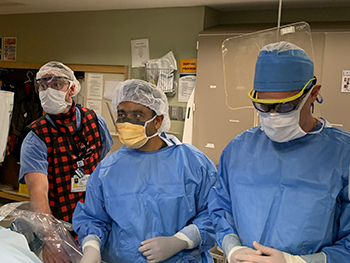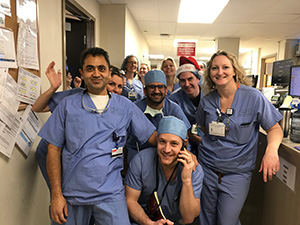About the Program
We are a medium sized city in Upstate New York, located between Buffalo and Syracuse, along the shores of Lake Ontario. We serve Western New York from Syracuse to Buffalo, down to Northern Pennsylvania. The University of Rochester Medical Center, over 700 beds, with the free-standing Golisano Children’s Hospital and the Wilmot Cancer Center, offers training programs in virtually all specialties. It is also the largest employer in Rochester, New York.
The Interventional Radiology section at University of Rochester Medical Center has a 40 year history of education, innovation and research in IR. Many of our past trainees practice at prestigious organizations and thriving private and academic institutions around the USA. Some recent examples include programs at Mallinckrodt, Michigan, Chicago, Stanford, University of California, Duke and of course, our own programs at University of Rochester.
Applications for the Interventional Radiology - Integrated Program are accepted through ERAS.
Mission Statement
The Interventional Radiology Residency Program - Integrated at University of Rochester seeks to be the preferred Western New York entity for patients, providers and trainees in interventional radiology patient care and education.
Program Aims
The Program aims to achieve its mission by focusing on the four pillars of academics-patient care, education, research and inclusivity. We will: -provide the best patient care in a patient centered environment with specific attention to each patient's values, beliefs and needs. -provide a rigorous and immersive learning experience to our trainees in a nurturing environment that encourages critical thinking and fosters collegiality. -create and maintain a robust environment for original research designed to improve safety and patient outcomes. -ensure that diversity in thoughts, processes and individuals is not just encouraged but insisted upon.
 What Makes Us Unique
What Makes Us Unique
The University of Rochester/Strong Memorial Hospital offers a American College of Graduate Medical Education (ACGME) accredited five-year residency in interventional radiology. The residency program extends from Post Graduate Year PGY-2 through PGY-6. Successful completion of an ACGME approved clinical PGY-1 is necessary before commencing training. A preliminary year in surgery is recommended.
The Interventional Radiology - Integrated Residency provides experience in general diagnostic radiology through sub-specialty areas of pulmonary, abdominal, emergency, neurological, musculoskeletal, and pediatric radiology. Skilled interpretation of magnetic resonance imaging, computed tomography, ultrasonography, nuclear medicine, and computed radiography is an important focus of the program. Training in women's imaging and radiation physics round-out a comprehensive 3-year diagnostic radiology curriculum which meets or exceeds American Board of Radiology (ABR) requirements.
The final two years provide for an immersive experience in Interventional Radiology. Most of the two years are spent at the University of Rochester Medical Center in our primary hospital. Procedures range from image guided drainage of fluid collections to various areas: fistilagrams, angiography, Interventional Oncology, biliary interventions, TIPSS, BRTO, pre-operative embolizations, Pediatric IR, varicose vein treatments, pain management and various other interventions.
Residents have their dedicated out-patient clinic where they consult on out-patients both pre and post procedure. The philosophy of the clinic aims to mimic a surgical practice.
The Department of Imaging Sciences performs over 600,000 examinations annually at Strong Memorial Hospital and its outpatient facilities. An additional 90,000 examinations are performed each year at nearby Highland Hospital.
Specialty rotations are assigned at levels of increasing sophistication and experience. Individual responsibilities for procedures, film interpretation, teaching, and consultation are expanded as the resident advances through the program.
Programs Strengths
 Resident trainees have access to Strong Memorial Hospital, and several satellite clinics. The high volume and diversity of the cases our trainees are exposed to in this environment helps ensure a very rich clinical experience. A new free-standing 8 story children's hospital (Golisano Children’s Hospital) opened in July 2015 and a new Imaging Sciences/Pediatric Ambulatory Building which opened in 2017.
Resident trainees have access to Strong Memorial Hospital, and several satellite clinics. The high volume and diversity of the cases our trainees are exposed to in this environment helps ensure a very rich clinical experience. A new free-standing 8 story children's hospital (Golisano Children’s Hospital) opened in July 2015 and a new Imaging Sciences/Pediatric Ambulatory Building which opened in 2017.
Residents receive comprehensive training in a wide variety of radiological subspecialties, imaging modalities and advanced procedures. We were one of the first programs in the nation to implement PACS, and have remained at the forefront of imaging technology through research and collaboration with industry such as Carestream/Kodak.
The University of Rochester Medical Center employs accomplished, influential and nationally recognized faculty within the Department of Imaging Sciences furthermore residents meet and learn from distinguished visiting professors and board examiners.
The University as a whole has grown to be the greater Rochester region's largest employer with over 22,000 full-time equivalent jobs, making the University the seventh largest private employer in New York State.
A faculty of full and part-time board-certified radiologists and Ph.D.s with subspecialty expertise in their respective areas participate in supervision, teaching, and research.
Training Experiences
The final two years provide for an immersive experience with the capability of offering training at the above diverse sites, trainees are exposed to virtually all types of interventions. Our recent graduates have logged over 1200 cases in their one year of fellowship, and we expect the same volume for each IR trainee during, and after, transition to IR residency programs. Our busy, high acuity primary training site, coupled with a strong focus on out-patient interventions and dedicated clinic assures our graduates of excellent technical skills supplemented by strong clinical training.